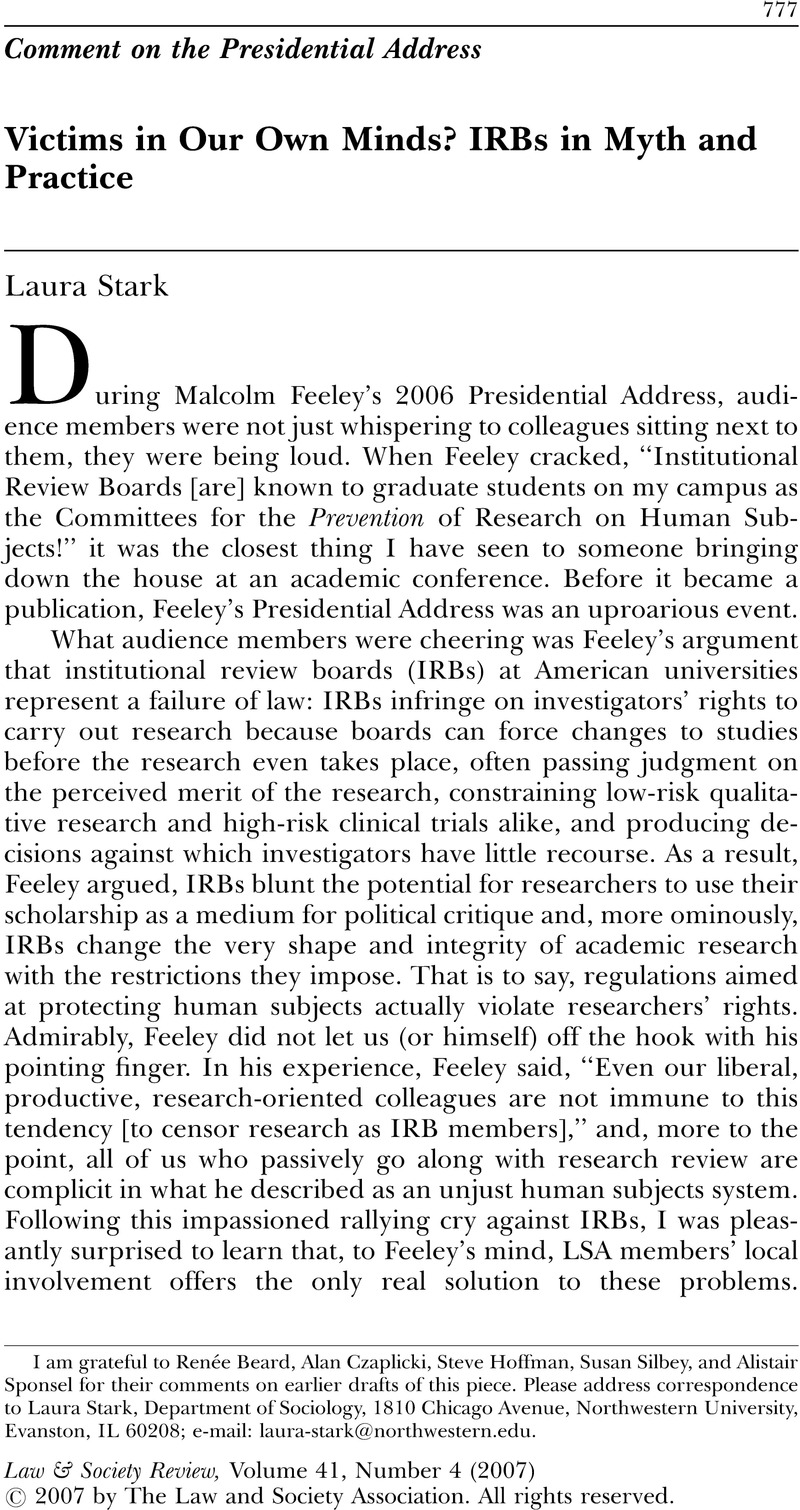Crossref Citations
This article has been cited by the following publications. This list is generated based on data provided by Crossref.
Borenstein, Jason
2008.
The Expanding Purview: Institutional Review Boards and the Review of Human Subjects Research.
Accountability in Research,
Vol. 15,
Issue. 3,
p.
188.
Bonnet, François
and
Robert, Bénédicte
2009.
La régulation éthique de la recherche aux États-Unis : histoire, état des lieux et enjeux.
Genèses,
Vol. n° 75,
Issue. 2,
p.
87.
Stark, Laura
2010.
The science of ethics: Deception, the resilient self, and the APA code of ethics, 1966–1973.
Journal of the History of the Behavioral Sciences,
Vol. 46,
Issue. 4,
p.
337.
Taylor, Judith
and
Patterson, Matthew
2010.
Autonomy and Compliance: How Qualitative Sociologists Respond to Institutional Ethical Oversight.
Qualitative Sociology,
Vol. 33,
Issue. 2,
p.
161.
Heimer, Carol A.
and
Petty, JuLeigh
2010.
Bureaucratic Ethics: IRBs and the Legal Regulation of Human Subjects Research.
Annual Review of Law and Social Science,
Vol. 6,
Issue. 1,
p.
601.
Librett, Mitch
and
Perrone, Dina
2010.
Apples and oranges: ethnography and the IRB.
Qualitative Research,
Vol. 10,
Issue. 6,
p.
729.
Wynn, L. L.
2011.
Ethnographers’ Experiences of Institutional Ethics Oversight: Results from a Quantitative and Qualitative Survey.
Journal of Policy History,
Vol. 23,
Issue. 1,
p.
94.
Hessler, Richard M.
Donnell-Watson, D. J.
and
Galliher, John F.
2011.
A Case for Limiting the Reach of Institutional Review Boards.
The American Sociologist,
Vol. 42,
Issue. 1,
p.
145.
Tuchman, Gaye
2011.
Ethical Imperialism: Institutional Review Boards and the Social Sciences, 1965–2009.
Contemporary Sociology: A Journal of Reviews,
Vol. 40,
Issue. 5,
p.
617.
Price, Patricia L.
2012.
Geography, Me, and the IRB: From Roadblock to Resource.
The Professional Geographer,
Vol. 64,
Issue. 1,
p.
34.
Price, Patricia L.
2012.
Introduction: Protecting Human Subjects Across the Geographic Research Process.
The Professional Geographer,
Vol. 64,
Issue. 1,
p.
1.
Ahern, Kathy
2012.
Informed consent: are researchers accurately representing risks and benefits?.
Scandinavian Journal of Caring Sciences,
Vol. 26,
Issue. 4,
p.
671.
Charlesworth, Andrew
2012.
DATA PROTECTION, FREEDOM OF INFORMATION AND ETHICAL REVIEW COMMITTEES.
Information, Communication & Society,
Vol. 15,
Issue. 1,
p.
85.
Martin, Deborah G.
and
Inwood, Joshua
2012.
Subjectivity, Power, and the IRB.
The Professional Geographer,
Vol. 64,
Issue. 1,
p.
7.
Trudeau, Dan
2012.
IRBs as Asset for Ethics Education in Geography.
The Professional Geographer,
Vol. 64,
Issue. 1,
p.
25.
Emmerich, Nathan
2013.
Between the accountable and the auditable: Ethics and ethical governance in the social sciences.
Research Ethics,
Vol. 9,
Issue. 4,
p.
175.
Jaspers, Patricia
Houtepen, Rob
and
Horstman, Klasien
2013.
Ethical review: Standardizing procedures and local shaping of ethical review practices.
Social Science & Medicine,
Vol. 98,
Issue. ,
p.
311.
Guta, Adrian
Nixon, Stephanie A.
and
Wilson, Michael G.
2013.
Resisting the seduction of “ethics creep”: Using Foucault to surface complexity and contradiction in research ethics review.
Social Science & Medicine,
Vol. 98,
Issue. ,
p.
301.
Bell, Kirsten
and
Elliott, Denielle
2014.
Censorship in the name of ethics: critical public health research in the age of human subjects regulation.
Critical Public Health,
Vol. 24,
Issue. 4,
p.
385.
Wright, Megan S.
and
Robertson, Christopher T.
2014.
Heterogeneity in IRB Policies with Regard to Disclosures about Payment for Participation in Recruitment Materials.
Journal of Law, Medicine & Ethics,
Vol. 42,
Issue. 3,
p.
375.



